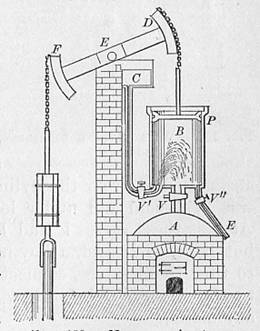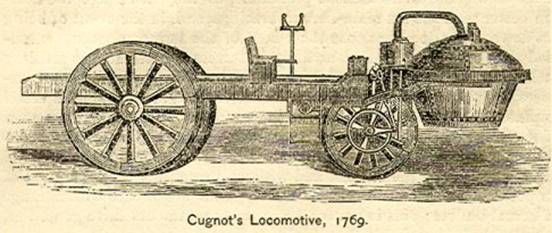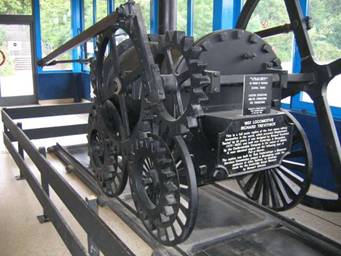by Muhammad Fadhli Mustaffa
The idea to use steam power to our advantage dates nearly twenty-one centuries. In ancient Alexandria, a learned writer named Hero wrote a manuscript describing various devices and ideas of the time. There is no proof that Hero was the inventor of any of these devices, but he is given credit for the earliest mention of steam power. He illustrated a method to open the doors of a temple with the action of a fire on the altar at the front of the temple. A series of pipes runs between the altar and the temple doors. The force of the steam created by the fire on the altar is strong enough to open the doors. The essential principle that Hero used was to change energy from heat into mechanical energy or work.
In 1679, Denis Papin (1647 – 1712) invented the steam digester, which was a type of pressure cooker. After observing and researching on the mechanical power of compressed steam, he then built a model of a piston steam engine in 1690.
Thomas Savery (1650 – 1715), an English military engineer, developed Papin’s ideas into a practical engine and he patented a crude form of steam engine in 1698. He had been working on the problem of pumping water out of coal mines. His invention consisted of a closed vessel filled with water into which pressurised steam was introduced. This forced the water upwards and out of the mine shaft. A cold water sprinkler was then used to condense the steam, which created a vacuum that sucked more water out of the mine through a bottom valve.

Thomas Newcomen (1663 – 1729) was an English blacksmith who invented the atmospheric steam engine. This was an improvement over Thomas Slavery’s previous design. Slavery actually worked with Newcomen on the engine. The Newcomen steam engine used the force of atmospheric pressure to do the work. After steam is pumped into a cylinder in the engine, it was then condensed by cold water which created a vacuum on the inside of the cylinder. The resulting atmospheric pressure operated a piston, creating downward strokes. In 1712, Thomas Newcomen and John Calley built their first engine on top of a water filled mine shaft and used it to pump water out of the mine.
In 1765, James Watt, working for the University of Glasgow, was assigned the task of repairing a Newcomen engine. While repairing the engine, Watt saw a way to improve its efficiency significantly. The Newcomen engine wasted a lot of steam. Watt realized that this could be avoided by having a condensation chamber separate from the cylinder, but connected to it. This allows the condenser to be cool while the cylinder remains hot. Watt’s design had a condenser that could be cool while the cylinder was hot. The design was patented in 1769. The first two steam engines with his new design were installed in 1776. Watt’s engine soon became the dominant design for all steam engines at the time and played an important role in the Industrial Revolution.

A French military engineer called Nicolas-Joseph Cugnot (1725 – 1804) invented a self propelled three-wheeled vehicle which he called “Fardier à vapeur” or “steam wagon”. The vehicle was developed for towing artillery and it could carry four people. In 1769, Cugnot demonstrated his first steam engine before distinguished government officials in the Paris arsenal. The machine reached a speed of 2mph and ran for 15 minutes. The following year he built an improved version. The heavy vehicle had two wheels in the back and one in the front, which supported the steam boiler and was steered by a tiller. In 1771, during a demonstration to the French public, his vehicle crashed into a brick wall. The accident together with budget problems ended the French Army’s experiment with mechanical vehicles. The lack of support prevented Cugnot from further engine developments. In 1772, King Louis XV granted Cugnot a pension of 600 francs a year for his innovative work.
Mining engineer Richard Trevithick (1771-1833) from Cornwall built the first self-moving engine in Britain. Unlike James Watt, Trevithick preferred higher steam pressures that gave greater power from smaller cylinders. On 21 February, 1804, Trevithick’s engine hauled 10 tons of iron and 70 men nearly ten miles from Penydarren, at a speed of 5mph. He built several steam road carriages, the first steam railway locomotives and many stationary steam engines. His ideas were ahead of his time, but his inventions were not commercially successful, so unfortunately he died penniless at the age of 62.
Although Trevithick was the first to run steam engines on rails, George and Robert Stephenson’s “Rocket” is usually thought to be the first steam locomotive by most people. In fact, George Stephenson had already designed a few locomotives before 1829. His first locomotive was designed in 1814. ‘Blutcher’, as it was called, was a travelling engine designed for hauling coal on a coal site. It could haul 30 tons of coal in a load, and was the first successful flanged-wheel adhesion locomotive.
In 1821, planning on the Stockton and Darlington Railway began. Initially, the company director Edward Pease planned to use horses to draw coal carts over metal rails, but after he met Stephenson, he agreed to change plans. In September 1825, Stephenson completed the first locomotive for the new railway. It was named “Active”, but then it was changed to “Locomotion”. During the Stockton and Darlington Railway opening on 27 September 1825, Stephenson drove “Locomotion” himself. It hauled 80 tons of coal and flour for 15 km over two hours, reaching a speed of 39 km/h over one stretch. The first purpose-built passenger car, called “Experiment”, was also attached. It carried a load of dignitaries for the opening journey.

It was in 1829 that the famous “Rocket” was built. It was the first ‘modern’ locomotive, introducing several innovations that were used on almost every steam locomotive built since. “Rocket” used a multi-tubular boiler, which was more efficient as the heat transfer between the exhaust gases and the water was more effective. Previous boilers consisted of a single pipe surrounded by water. The “Rocket” also used a blastpipe for the first time. The blast of exhaust steam was used to produce a partial vacuum which creates a draught to pull air through the fire.
The “Rocket” was designed and built to enter a competition to decide who would build the locomotives for the new Liverpool & Manchester railway. Its impressive performance in winning the contest made it one of the most famous machines in the world. When the railway opened on 15 September 1830, the opening ceremony was a considerable event, drawing top names from the government and industry, including the then Prime Minister, the Duke of Wellington. However, the day was marred by a tragedy, the first railway casualty in history. William Huskisson, the Member of Parliament for Liverpool, was struck and killed by “Rocket”. Nevertheless, the railway was a success. Stephenson had made a name for himself. Afterward, he was offered the position of chief engineer for numerous railways. The “Rocket” still exists. It is kept in the Science Museum, London, although in a modified form compared to its state at the Rainhill Trials
Diesel and electric locomotives began replacing steam locomotives by the middle of the 20th century. As labour costs rose, especially after the Second World War, non-steam technologies became much more cost-efficient. Most countries had completely replaced steam locomotives in commercial service by the end of the 1970s. Later, freight locomotives were also replaced. The “Evening Star” was the last express locomotive to be built in Britain.
By the end of the 20th century, nearly every steam powered locomotive that are still in regular use in North America and Western European countries were on heritage railways. Steam locomotives are still used regularly in some parts of China, where there is a large amount of coal. In the 1990s, India changed from steam powered trains to those powered by electricity and diesel. In some mountainous and high altitude rail lines, steam engines remains to be used since the reduced air pressure in those areas do not affect steam engines much compared to diesel engines.

[…] utilised in improving the old steam locomotive to make it more compatible in the 21st century. Who Invented the Steam Engine? The steam engine was not invented by only one person but like all other great inventions and great […]
Pingback by Welcome « A 21st Century Vision of Steam Traction — 25 June 2008 @ 5:11 pm
[…] https://straction.wordpress.com/history-of-the-steam-engine/ […]
Pingback by Creation of Trains | The Industrial Revolution & Railroads — 17 January 2013 @ 11:01 pm
joezelinski.com
History of the Steam Engine | A 21st Century Vision of Steam Traction
Trackback by joezelinski.com — 11 June 2014 @ 10:43 pm